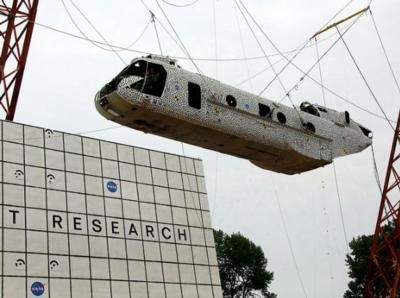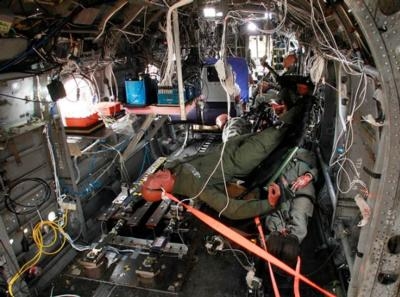Experiment To Test Improved Seats And Seatbelts, Gather Accident Data
Engineers at NASA's Langley Research Center in Hampton, VA., dropped an old Marine CH-46E helicopter fuselage filled with 15 dummy occupants from a height of about 30 feet Wednesday to test improved seats and seatbelts and gather data on the odds of surviving a helicopter crash. They used cables to hoist the helicopter fuselage with its mock passengers into the air and swing it to the ground, much like a pendulum. It was traveling at 30 mph when pyrotechnic devices separated the cables and let the fuselage hit the soil at Langley's Landing and Impact Research Facility.

"We designed this test to simulate a severe but survivable crash under both civilian and military requirements," said NASA lead test engineer Martin Annett. "It was amazingly complicated with all the dummies, cameras, instrumentation and the collaborators, but it went well."
The fuselage hit hard. Thirteen instrumented crash-test dummies and two un-instrumented manikins had a rough ride, as did some of the 40 cameras mounted inside and outside the fuselage. Preliminary observations indicate good data collection, which will take months to analyze. Researchers used the cameras as well as onboard computers, which data from 350 instrumentation points, to record every move of the 10,300-pound aircraft and its contents. The helicopter's unusual black-and-white-speckled paint job -- a photographic technique called full field photogrammetry -- also aided in the data collection effort. "High speed cameras filming at 500 images per second tracked each black dot, so after everything is over, we can plot exactly how the fuselage reacted structurally throughout the test," said NASA test engineer Justin Littell.
This was the first of two planned tests using Navy-provided CH-46E Sea Knight fuselages. A similar helicopter equipped with additional technology, including high-performance, lightweight composite airframe retrofits, will be used in a crash test next summer. Both are part of the Rotary Wing Project in NASA's Aeronautics Research Mission Directorate.

NASA will use the results of both tests in efforts to improve rotorcraft performance and efficiency. Researchers also want to increase industry knowledge and create more complete computer models that can be used to design better and safer helicopters. The ultimate goal of NASA's rotary wing research is to help make helicopters and other vertical take-off and landing vehicles more serviceable -- able to carry more passengers and cargo -- quicker, quieter, safer and greener, and lead to more extensive use in the airspace system.
The test was a collaboration between NASA, the U.S. Navy, U.S. Army and the FAA. For this test, Langley used six of its own crash test dummies. In addition to the fuselage, the Navy contributed seats, crash test dummies, a manikin and other elements of the test. The Army provided a manikin and a crash test dummy that simulated a patient lying in a stretcher. The Federal Aviation Administration provided a side-facing specialized crash test dummy and part of the data acquisition system. Cobham Life Support-St. Petersburg, a division of CONAX Florida Corporation, contributed an active restraint system for the cockpit.
(Images provided by NASA)
 Classic Aero-TV: Extra; the Airplane, the Man, and His Grand DeLand Plan
Classic Aero-TV: Extra; the Airplane, the Man, and His Grand DeLand Plan ANN FAQ: Follow Us On Instagram!
ANN FAQ: Follow Us On Instagram! Aero-News: Quote of the Day (11.27.25)
Aero-News: Quote of the Day (11.27.25) ANN's Daily Aero-Term (11.27.25): Ultralight Vehicle
ANN's Daily Aero-Term (11.27.25): Ultralight Vehicle ANN's Daily Aero-Linx (11.27.25)
ANN's Daily Aero-Linx (11.27.25)




